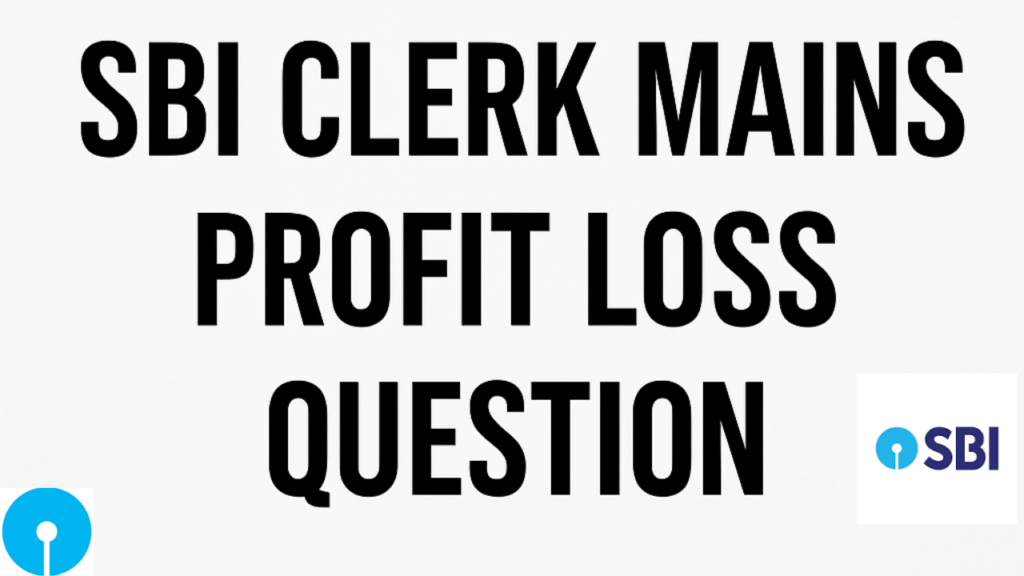
The SBI Clerk Mains exam is known for its tricky and challenging questions, especially in the Quantitative Aptitude section. A recent Profit and Loss question has left even the most dedicated banking aspirants struggling to find the right answer. With complex calculations and tricky conditions, only those with strong problem-solving skills can crack it. Are you ready to take on the challenge and test your skills?
SBI Clerk Mains Exam Pattern 2024
The SBI Clerk Mains Exam consists of four sections: General/Financial Awareness, General English, Quantitative Aptitude, and Reasoning Ability & Computer Aptitude. The exam follows the pattern below:
| Section | Number of Questions | Maximum Marks | Duration |
|---|---|---|---|
| General/Financial Awareness | 50 | 50 | 35 minutes |
| General English | 40 | 40 | 35 minutes |
| Quantitative Aptitude | 50 | 50 | 45 minutes |
| Reasoning Ability & Computer Aptitude | 50 | 60 | 45 minutes |
| Total | 190 | 200 | 2 hours 40 minutes |
Important Points:
- Negative Marking: 0.25 marks deducted for each incorrect answer.
- Sectional Timing: Each section has a fixed time limit.
- No Sectional Cutoff: Only overall cutoff marks are considered.
- Final Selection: Based on Mains exam marks; no interview is conducted.
SBI Clerk Mains Profit Loss Question:
Sonu and Monu had a total sum of Rs. 20,000 with them. Sonu lent out his money at the rate of 40% p.a. compound interest and got Rs. ‘8p’ interest after two years. Monu lent out his money at the rate of 18% p.a. simple interest and got a total amount of Rs. ‘17p’ after 2 years. Find the interest (in Rs.) obtained by
Monu.
Importance of the Profit and Loss in SBI Clerk Mains Exam:
1. Introduction
Profit and Loss is one of the most frequently tested topics in the SBI Clerk Mains exam. While it may seem like a basic arithmetic topic, many aspirants find it challenging due to the complex variations of questions that appear in the exam. Questions often involve multiple concepts like successive discounts, false weight problems, and marked price confusion, making them difficult to solve within the given time limit.
In this article, we’ll discuss why even the best banking aspirants struggle with certain Profit and Loss questions. We will analyze the complexity of these questions, common mistakes students make, and strategies to solve them quickly and accurately. Get ready to test your skills with one of the toughest Profit-Loss questions in SBI Clerk Mains!
2. The Complexity of Profit-Loss Questions in SBI Clerk Mains
While Profit and Loss is a fundamental arithmetic concept, the difficulty level increases significantly in SBI Clerk Mains due to the advanced question patterns. Below are some common variations that aspirants find tricky:
a) Successive Discounts and Marked Price Confusion
Many aspirants get confused between successive discounts and single discounts. For example, a 20% discount followed by a 10% discount is not a 30% discount; instead, it follows the successive discount formula:

Where A and B are the two discount percentages. This concept is frequently tested in the exam and often leads to errors.
b) False Weight and Wrong Selling Price Questions
These questions involve fraudulent sellers who cheat customers by giving less weight than advertised or marking up the price before offering a discount. Many students struggle to set up the correct equation to solve these problems.
For example, if a shopkeeper claims to sell 1 kg of sugar but actually gives 950g, how does it affect his profit percentage? This kind of question requires strong conceptual clarity.
c) Cost Price, Selling Price, and Markup Confusion
A common mistake students make is misunderstanding the relationship between cost price, selling price, and markup. Sometimes, the exam provides a question where the shopkeeper first marks up the price and then gives a discount, making the calculation tricky.
For example:
- A shopkeeper marks up an item by 40% and then offers a 25% discount. What is his profit percentage?
- Many aspirants directly subtract the two percentages, which is incorrect. Instead, the correct formula involves successive percentage calculations.
d) Time-Consuming Calculation-Based Questions
SBI Clerk Mains is a speed-based exam, meaning aspirants must solve questions quickly and accurately. Profit and Loss problems often require complex calculations, which can slow down candidates. Without shortcuts or smart approaches, aspirants waste too much time on a single question.
SBI Clerk Mains Conclusion of These Two Points
Understanding the depth of Profit and Loss questions is crucial for SBI Clerk Mains aspirants. The exam does not test only basic concepts but integrates advanced problem-solving skills, requiring candidates to think critically. In the next sections, we’ll explore real SBI Clerk Mains Profit and Loss questions, discuss common mistakes, and provide shortcuts to help you solve them efficiently. Stay tuned! 🚀